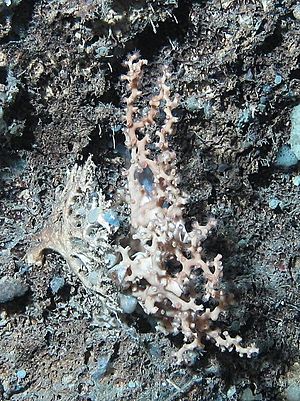Tasmanian Seamounts facts for kids
Quick facts for kids Tasmanian Seamounts |
|
|---|---|
|
Lua error in Module:Location_map at line 420: attempt to index field 'wikibase' (a nil value).
|
|
| Summit depth | 660 and 1,700 m (2,000 and 6,000 ft) |
| Height | 300 to 600 m (1,000 to 2,000 ft) |
| Summit area | 25 km (16 mi) across |
| Location | |
| Location | South of Tasmania |
| Country | Australia |
| Geology | |
| Type | Seamounts (underwater volcanoes) |
| Age of rock | ~55 million years old |
The Tasmanian Seamounts are a group of huge underwater mountains found south of Tasmania, Australia. These amazing mountains are actually underwater volcanoes. They were formed over 55 million years ago by a special hot spot deep inside the Earth.
These seamounts are very important for ocean life. They are home to a rich and thriving marine ecosystem. However, they have faced dangers from too much fishing. Because of this, a large part of the Tasmanian Seamounts became a protected marine reserve in 1999. This helps keep their unique ocean life safe.
How the Tasmanian Seamounts Formed
The Tasmanian Seamounts were created by something called the Tasman hotspot. Imagine a giant, super-hot column of rock rising from deep inside the Earth. This column is about 4,000 kilometers (2,500 miles) long! Today, this same hotspot is active under Mount Erebus in Antarctica.
About 55 million years ago, as the Earth's plates moved, this hotspot created the Tasmanian Seamounts. These underwater mountains are found between 1,000 and 2,000 meters (3,300 to 6,600 feet) deep. They are about 25 kilometers (15.5 miles) wide and stand 200 to 500 meters (660 to 1,600 feet) tall from the seafloor.
Amazing Ocean Life
The Tasmanian Seamounts are a vital part of the ocean environment south of Tasmania. Normally, the deep ocean doesn't have many nutrients. But seamounts change that! Their shape makes ocean currents flow faster around them. This fast-moving water cleans the rocks and brings food to animals that filter feed.
The clean rocks are perfect places for sponges and corals to attach. Some of these creatures can live for hundreds or even thousands of years! The Tasmanian Seamounts are especially known for a type of stony coral called Solenosmilia variabeles. These corals create homes and hiding spots for many other animals.
You can find mollusks, echinoderms, and crustaceans living here. This includes stone crabs, squat lobsters, and top snails. While some of these species are also found closer to shore, they are much more abundant and healthy on the seamounts. This makes the seamounts a truly special place for ocean life.
Protecting the Seamounts
For many years, fishing boats used a method called trawling to catch fish like orange roughy around the seamounts. Trawling involves dragging large nets along the seafloor.
In 1994, scientists mapped the seafloor near Tasmania, including the seamounts. Soon after, a government report said that the animals living on the Tasmanian Seamounts were very diverse. But it also warned that they were not well-studied and were in danger from too much fishing. The report suggested creating an ocean reserve to protect them.
To learn more, fishing was temporarily stopped for three years in 1997. During this time, a study found 242 different kinds of invertebrates (animals without backbones). A large number of these were new to science, and about a third seemed to live only on the seamounts. The study also showed how much damage trawling caused. On the most affected seamounts, coral groups were destroyed, and many species were lost.
After the study, the Tasmanian Seamount Community marine reserve was created in 1999. This reserve banned fishing, especially trawling, in an area of 370 square kilometers (140 square miles). It included 70 seamounts that had not been heavily trawled, so they were still in good shape. In 2007, this reserve became part of the larger Huon Commonwealth Marine Reserve. A detailed survey that same year found a total of 123 seamounts within the reserve, many of which were previously unknown! This shows how much more there is to discover in our oceans.


